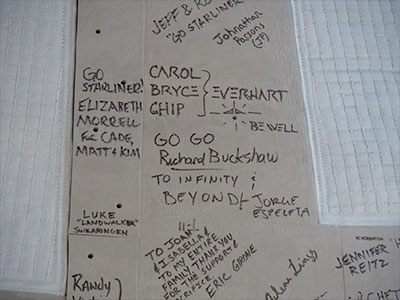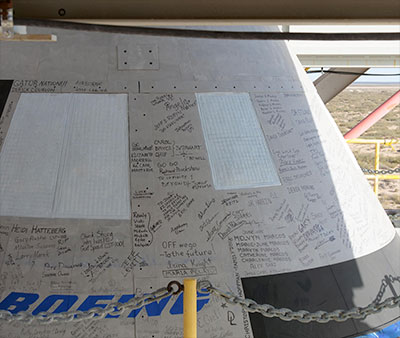 Space News space history and artifacts articles Messages space history discussion forums Sightings worldwide astronaut appearances Resources selected space history documents |
If you have previously registered, but forgotten your password, click here.
| ||||||||
| Robert Pearlman | NASA and Boeing have announced a new target date for the Pad Abort Test: Boeing Pad Abort Test: Nov. 4, 2019 at White Sands Missile Range in New Mexico. | |||||||
| Robert Pearlman | From NASA Administrator Jim Bridenstine, via Twitter: Thank you to Boeing. At my request, Monday's [Nov. 4] commercial crew Starliner pad abort test will be broadcast live. Transparency for the taxpayer.From Boeing, in response: We join you in your enthusiasm to share this Starliner test with the world live. Targeting a T-0 of 7 a.m. MT with a three-hour test window on Monday, Nov. 4. Tune into NASA TV | |||||||
| thisismills | In this photo it looks like the ascent cover has been signed by several people. Anyone know the story? 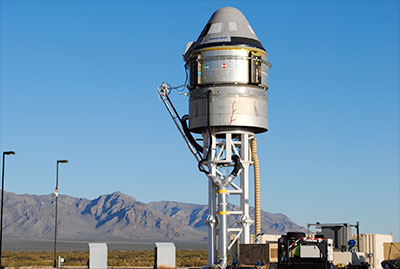 | |||||||
| Robert Pearlman | I've requested further details, but Boeing confirmed those are the signatures of the CST-100 Starliner team and contractors. | |||||||
| Robert Pearlman | From Boeing on Twitter: If you look closely at the Starliner Pad Abort spacecraft, you see the signatures of the employees who have dedicated thousands of hours to making it reality. Well wishes, famous quotes, hopes, dreams, even family members' names - they've all given so much to make it happen. 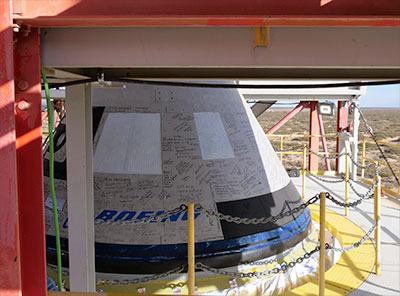 | |||||||
| hlbjr | The abort test went pretty well except only two of the three main parachutes deployed. | |||||||
| Robert Pearlman | From the video, it appears that all three main parachutes deployed, but only two unfurled. Starliner is qualified to land safely on two parachutes, so the test is still considered a success. As Chris Ferguson said after the test: I had this trajectory of what this pad abort would look like for a long time and to actually see it happen was just fantastic. And it worked pretty much as I had always envisioned. 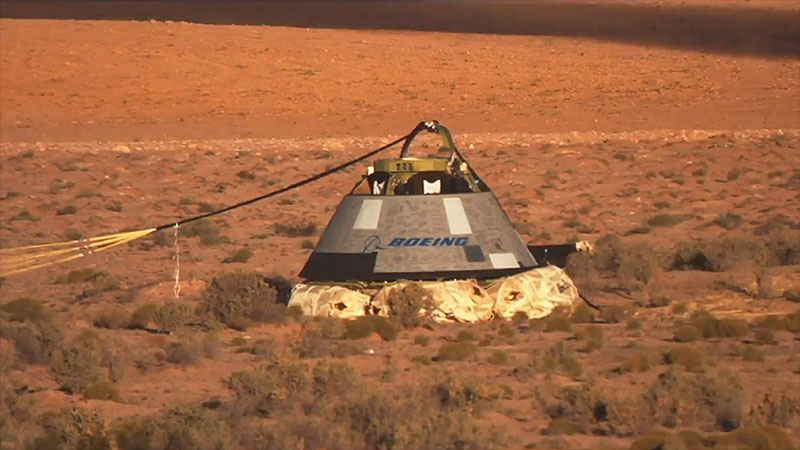 | |||||||
| Robert Pearlman | From Kathy Lueders, NASA's Commercial Crew Program manager: Tests like this one are crucial to help us make sure the systems are as safe as possible. We are thrilled with the preliminary results, and now we have the job of really digging into the data and analyzing whether everything worked as we expected. | |||||||
| Robert Pearlman | Boeing statement Today's pad abort test was a milestone achievement for our CST-100 Starliner team, for NASA, and for American human spaceflight. We will review the data to determine how all the systems performed, including the parachute deployment sequence. | |||||||
| Headshot | I know there was a "dummy" on board to simulate a crew member. Was additional mass placed on board to simulate a full crew load? | |||||||
| oly | Over the past few days I have read conflicting stories that describe the third parachute deployment anomaly as it either failed to deploy, or, it deployed but was separated from the vehicle during inflation. Has any additional information been released? | |||||||
| Robert Pearlman | The test was yesterday morning; Boeing said it would take two to three days to collect the spacecraft and begin analyzing the data collected. Chris Ferguson shared a little more in an interview with Spaceflight Now: "Some of the folks who have the opportunity to go back and review it say that the pilot chute did come out, but then we don't know what happened after that," Ferguson told Spaceflight Now. "The pilot chute is designed to pull the main chute out, and we confirmed that the pilot chute came out, which means that the mortar that fires the pilot chute functioned properly, but what happened beyond that, it's too early to speculate." | |||||||
| Robert Pearlman | Boeing will host a conference call with media at 1:30 p.m. EST on Thursday, Nov. 7 to address preliminary results of the pad abort test. | |||||||
| Robert Pearlman | Boeing has identified the root cause of main parachute deployment issue as "a lack of secure connection between the pilot chute and the main chute." A pin that was to hold the linkage between the pilot and main chute had been incorrectly inserted. The conclusion was reached based on close-out photos and inspection of the post-test hardware. The issue was not detected because a protective abbrasion sheath prevented view of the connecting lines. Boeing plans to take additional steps to mitigate this problem, including pull tests and additional inspections going forward. For the immediate future, engineers are now verifying that the linkages between all of the parachutes are secure on the Orbital Flight Test vehicle. Otherwise, Boeing has now verified that all other systems aboard Starliner worked as expected, including the abort engines, the separation lines and the thrusters that oriented the spacecraft during flight. | |||||||
| Robert Pearlman | Boeing video Go behind the scenes during Starliner's first flight that successfully put the Pad Abort system to the test. Watch the entire flight in real time with our photographer at White Sands Missile Range in New Mexico, as Starliner's launch abort engines ignite, propelling the vehicle roughly a mile up (approx. 1.6 km) and a mile away from the test stand in just about 90 seconds. | |||||||
| oly | quote: Connecting the pilot chute to the main chute is a fundamental step that any technician or rigger who works on parachutes, ejection seats, or even brake chutes have trained for. There are steps and inspections that cross-check these things carried out by others and certified within the associated documentation. In the aviation/aerospace industry, such practices are second nature, designed to catch such oversights. and something that is generally thought to be inexcusable to overlook. Quality checks and systems are designed to mitigate the risk of such things happening and any breakdown of procedure or failure of the safety or quality systems is generally something that makes big news. While NASA and Boeing were quick to reiterate that the vehicle design incorporated the loss of one main chute, serious questions should be raised about how such a step was overlooked. Consider what may have been if more than one main chute failed to deploy. | |||||||
| Headshot | I agree with Oly. The incorrect installation of the pin is bad. For that situation not to be discovered/corrected by Boeing prior to such an important test is even worse and could give a whole new connotation to Boeing's "Fewer Steps to the Moon" campaign. | |||||||

